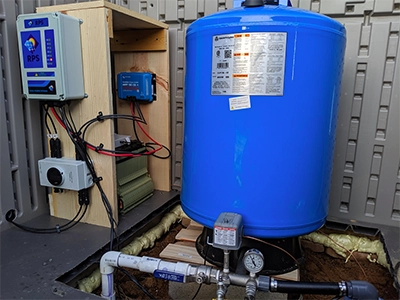Pressure Tank Assembly

What is a pressure tank?
When considering pressure tank assembly it is important to know what a pressure tank is, and when to use one. Pressure tanks don’t require any electricity, their internal water bladder fills and compresses purely using pressure. The pressure tank can be one of the main components of a well system, along with the pump, pressure switch and the well itself. It stores water from the well and supplies it to your home at an appropriate pressure. In most homes the pressure tank is responsible for the level of your water pressure. Pressure tanks are offered in a variety of sizes, from 5 gallons up to 200 gallon or more. For any off-grid solar pumping application we recommend purchasing the largest pressure tank you can find, as the larger tank will act as an above ground water storage resource and the pump won’t have to turn on as often.
Examples of pressure tank use cases…
For homes: providing water pressure to sinks, showers, faucets washing machines etc in the home. Usually water pressure is set in the 40-50 PSI range. Some people prefer stronger water pressure, closer to 70 PSI, and some off-grid cabins really only require 35 PSI.
For livestock: automatic waterers and frost free hydrant waterers that require 40 PSI like a Ritchie waterer need a pressure tank to consistently turn water on and off as the animals drink water down.
For irrigation: pressure tanks help regulate water pressure and flow better than a water pump on its own for irrigation applications greater than 15 PSI. Especially good to use when mixing irrigation of varying PSI requirements, like drip lines in one zone and sprinklers in another.
In the video below we will walk you through pressure tank assembly.
Installing a pressure tank with a solar well pump
Submersible pumps can’t provide 45 -60 psi for a households alone, they need a pressure tank for high pressure. Correct pressure tank assembly is an important. An RPS pump system could be used in this setup as they are all compatible with batteries (A), which you’ll need for off hour or nighttime pumping. Without batteries, the submersible pump would only operate during the day. After sun down you would only have what’s available in the pressure tank. We recommend a larger capacity pressure tank for off grid set up, it provides some extra storage. Two pieces of special plumbing are needed to make the system work; a check valve and a reverse action pressure switch. (C)

The reverse action pressure switch (D) senses changes in pipeline pressure, if the pressure tank is draining and therefore asking for more water, or filled up. The reverse action pressure switch is wired into the charge controller and will send a sensor pulse to either turn on the pump (if the pressure tank is asking for water) or turn the pump off (if the pressure tank is full). Reverse action pressure switches are adjustable to a variety of settings like 40/60 , 30/50 or 20/40, we sell them here. Watch our video about adjusting a reverse action pressure switch here. If the water were allowed to drain back through the pump (which is sometimes useful in freeze proofing a system) then the reverse action pressure switch would be unable to sense the changes in line pressure. And if you’re worried about the pump turning on/off multiple times during the day – don’t be! Our submersible pumps are all soft start/ slow stop, meaning no grinding parts or start up torque. The above pressure tank assembly will work for all solar pumps!
Things you’ll need!
Below is a clickable list of things you’ll need that we mentioned in the video above!
- Reverse Action Pressure Switch
- Check Valve
- Pressure Tank
- Over Pressure Relief Valve
- Tank Tee
- Ball Valve
- Pressure Gauge
- 1″ PVC
Be sure to double check the size of each fitting to ensure they are a match for your project!
How to size your pressure tank
Sizing an off-grid pressure tank for a well is a three-step process of knowing the flow rate, the minimum runtime of the pump, and the pressure switch setting. These three variables must be calculated together to find what size pressure tank works for a system and to decide what the best pressure tank assembly for you. You should also know that although you may purchase a 50 gallon pressure tank, you’ll only receive about 75% of that water before the pump has to turn on again to re-pressurize and fill the pressure tank. Follow these steps to properly size your well pressure tank:
1. Flow Rate
Your flow rate is how many gallons per minute your pump produces.
2. Minimum Runtime
Multiplying the flow rate by the minimum runtime of the pump will give you the drawdown capacity. The minimum runtime rule of thumb is any pump operating at 10 gallons per minute (GPM) or under should be producing one gallon per minute of runtime.
(For example, 10 GPM flow rate x 1 = 10 gallon drawdown capacity.)
Anything above 10 GPM should be producing 1.5 gallons per minute of runtime.
(For example, 16 GPM flow rate x 1.5 = 24 gallon drawdown capacity.)
If your flow rate is above 20, you may require multiple tanks, or opt for a larger pressure tank in the 100-200 gallons capacity range.
3. Pressure Switch Setting
The pressure switch setting is the pressure at which the pump turns on to fill the tank up, and the pressure at which the pump shuts off, knowing the tank is full. The three pressure switch settings for pressure tanks are 20/40, 30/50, and 40/60. The first number is the pressure at which your pump turns back on and the second number is the pressure at which your pump turns off (i.e. 20psi on, 40 psi off). The number that turns off the pump pressure is going to have the most direct effect on your drawdown capacity. For example, if you have a 40/60 switch, you are going to have less drawdown capacity than you would have on a 30/50 switch.
Most well pressure tank manufacturers will provide you will a chart to tell you what your drawdown capacity is based upon the pressure switch setting.
For more information check out our friends over at freshwatersystems.com
Considering Multiple Pressure tanks?
Pressure tanks can be linked together! Three 40 gallon pressure tanks can be linked together to form 120 gallons of stored, pressurized water.
Alternative Method for Sizing – Based on Use
Think about what the worst case flow rate your household would be using at one time, say if the washing machine, shower and sink we’re all operating at the same time then you’d have about 15 GPM flowing out of the pressure tank. Then, ask yourself how long all three of those appliances would be operating together, worst case. If you think that all three could be operating at the same time over a 5 minute period, that means…
15 gallons per minute x 5 minutes = 75 gallons over 5 minutes
Lets say that you have a 50 gallon pressure tank
And the pressure tank will need to start refilling after about 75% of its water is drained. If there’s an imbalance of inflow (your pump only produces 5 gallons per minute and your house is consuming 15 gallons per minute) there might be some sputtering water coming out of the faucets or flow reduction.
As long as your well is strong enough to supply replacement water at that rate, then you’ll be fine. However, in this scenario our team would recommend purchasing a 100 gallon pressure tank, so that your 75% rule means you’ve got 75 gallons of water ready to go at any time.
Low producing wells beware here, do not buy a small pressure tank if you have higher flow needs – always choose a larger capacity pressure tank for low producing wells.
